Jack Erickson's Blog, page 8
March 5, 2012
Agincourt Reef
Agincourt Reef
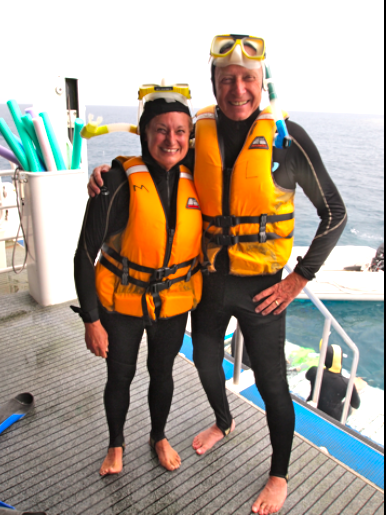
Recognize anyone?
A day after we arrived in Cairns, we took an early morning bus to Port Douglas and boarded a boat for a day diving on Agincourt Reef, one of the ribbon reefs on the Continental Shelf of the Great Barrier reef. This was going to be a first diving experience for both of us, snorkeling and a couple introductory dives for me.
Cairns, Queensland
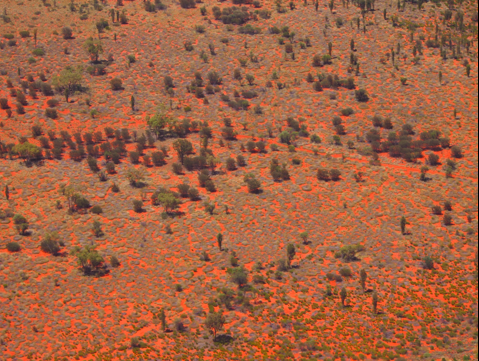
Red desert landscape approaching Uluru / Ayers Rock airport
It was our second full day in Cairns where we had flown from Alice Springs in the Northern Territories. We opted for a longer flight by flying west to Uluru / Ayers Rock and then flying east to Cairns. This longer flight gave us an opportunity to view the Red Center where we had spent the last week hiking and exploring the Macdonnnell Range, Kata Tjuta and Uluru.
We had great arial views of the Red Center, particularly of the dried salt river and beds. They looked larger and more impressive from the air.
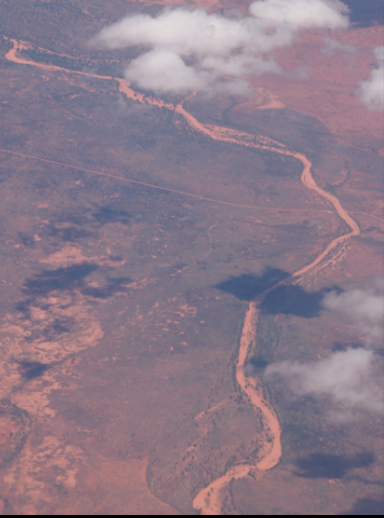
Dried river bed in Red Center
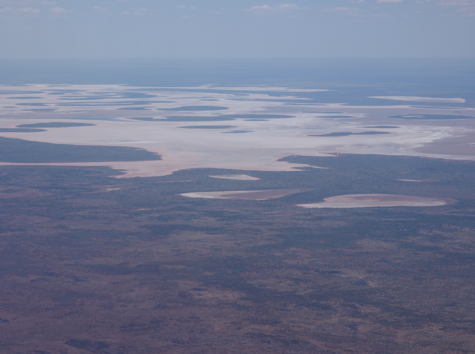
Salt lake bed in Red Center
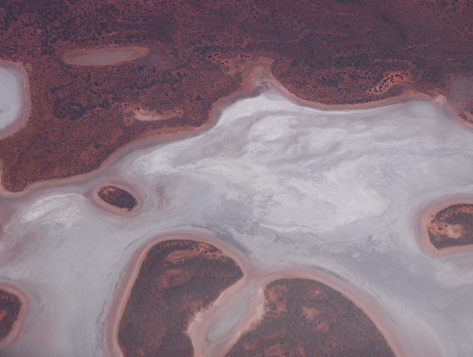
Dried salt lake bed
American government facilities near Alice Springs
We also flew near the joint CIA / US military listening post at Pine Gap where many Americans work and reside in Alice. Pine Gap is the largest CIA facility outside of the U.S. The facility has a large and controversial role involved in directing military air and drone strikes in the wars in Iraq and Afghanistan, including the ‘shock and awe’ air strikes in Baghdad.
Pine Gap is also controversial within the halls of the Australian government. Federal Australian officials are denied entry into the secret facility except in certain ‘joint exercise’ areas.

Secret Pine Gap CIA site west of Alice Springs
Americans also work at a NASA satellite tracking facility near Alice Springs monitoring electronics from various satellites and missions like the Voyager and Mars Landers. A NASA ground launched balloon recently malfunctioned at launch at the facility and caused a little damage on the ground with no injuries.
Port Douglas
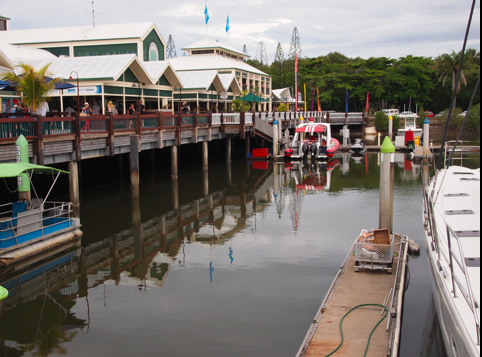
Port Douglas marina
Agincourt Reef is about 65 kilometers or a two-hour boat ride from Port Douglas. All of us, snorkelers, divers, and riders talked excitedly about being out on the reef, so close to the Continental reef.
Tour companies offer afternoon, day, or overnight trips to the reef. Resorts offer similar diving and snorkeling on the quays or off shore islands.
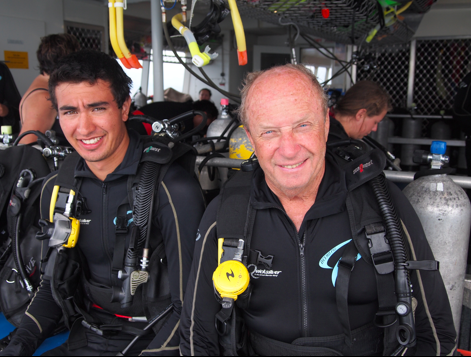
My dive buddy, from Manitoba, spent summer working on farm in Victoria
We were taking a three-day diving adventure later in the week, but wanted to get into the water, snorkel and experience the reef on an easy day trip first. We didn’t want to miss any opportunity to experience the Great Barrier Reef.
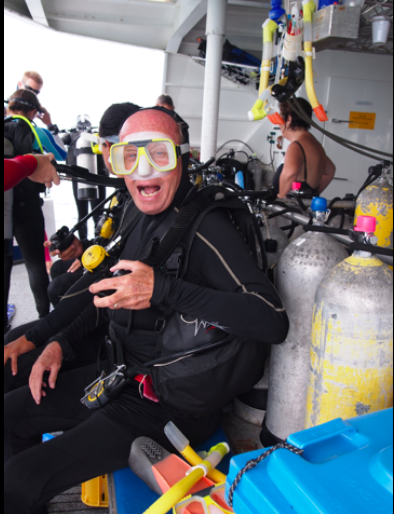
Did you mail my last life insurance premium?
Orientation dive
After an hour orientation about equipment, safety, and underwater communications, we suited up, slapped on weight belts, hoisted tanks onto our backs, checked regulators, snorkels, fins, masks, and CBD’s, and headed to the duck board on the back of the boat.
We put one hand over our head to hold our masks and the other hand over our regulator and stepped off into the water.
Once in the water, we switched to snorkels to get final instructions before heading down the tow line to the bottom. We changed back to regulators and slowly made our way down the line to the reef a few meters below. Within minutes, we were swimming among tropical fish; a beautiful experience.

Heading down tow line, three meters to the reef
Two dives
I made two dives that afternoon. It had been many years since I used scuba equipment in the Caribbean. So many technical improvements had been made in regulators, masks, tanks, and CBDs. The last time I dove, they didn’t have auxiliary regulators that fit a sleeve on the right arm. Something goes wrong with your regulator, grab your auxiliary and keep on breathing.
Snorkels had also improved; they now have a flap over the top to prevent water splashing into the tube, a risk in heavy seas.

Boarding after first dive, 8 meters, 30 minutes, saw reef shark and manta ray on the reef
Snorkeling on Agincourt
After a couple dives, we headed into the water again to snorkel together. The reef was about two meters below the surface, we swam along, surface diving to watch the tropical fish darting over the reef. Schools of silver, blue, fish swarmed around us, dazzling us with their numbers, colors, and speed. Amazing to see them the first time.
We couldn’t wait for our next diving adventure, a three-day over night trip off Cairns.
We met interesting people on the boat, snorkelers, divers, and my instructor who had migrated from Finland about ten years ago to live in the tropics and become a certified instructor. She even talks like an Aussie!
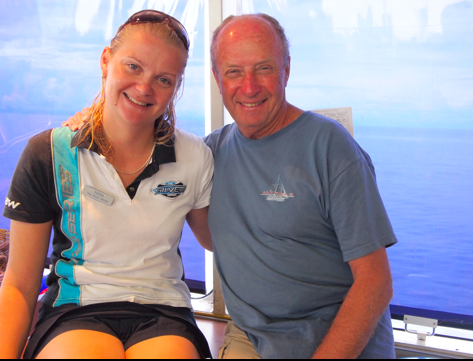
Vera, my Finnish diving instructor
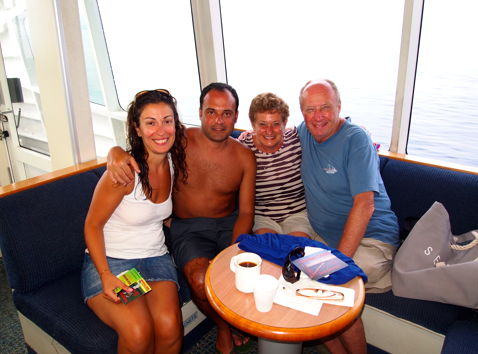
Agincourt Reef diving companions, Lisa from Melbourne and her Italian boyfriend, Marco from Italy
Agincourt reef was another Australian adventure for us, with more to come in Cairns and Queensland. We’re having fun!
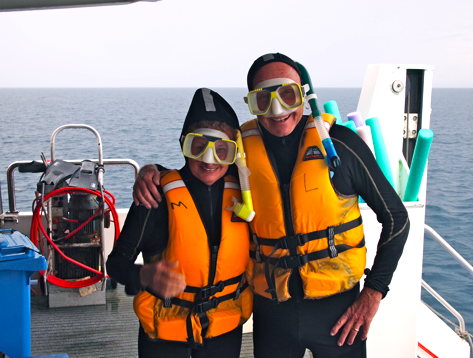
Missing gypsies; if you see, please report their location to proper authorities
* * * * *
Next: Three days diving on Great Barrier Reef
Please share your comments with us on our travels Down under. We want to hear from you!
In addition to this travel blog, I also write mysteries and romantic suspense novels available on Kindle, Nook,
and Smashwords which distributes to ereader devices. If you read books on ereaders, I hope you’ll consider
reading and reviewing them. I’ll be publishing a new murder mystery, REX ROYALE, in a few weeks. Let me
know if you’d like to read a preview of the opening chapters.
jacklerickson@gmail.com








February 29, 2012
Kangaroos in the bush
Kangaroos in the bush
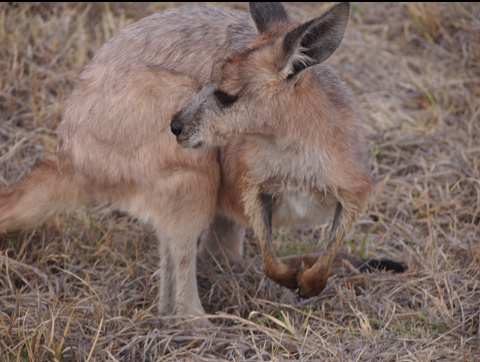
Young red kangaroo greeted us minutes after we arrived
Alice Springs most significant historical landmark is the historic telegraph station three kilometers north of town where the repeater station was set up by Charles Todd, postmaster of South Australia in 1872. This was one of the most historical events in Australian history, establishing telegraph lines from the Australia’s Top End (at Darwin on the Indian Ocean) to Adelaide, 2400 kilometers to the south.
The telegraph station was in operation for 60 years as part of the Overland Telegraph Line. It was later converted into a school for aboriginal children and became a national park in 1963.
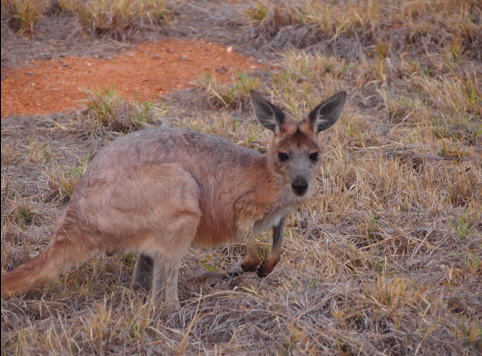
Watching us carefully
Today the Telegraph Station is one of Alice’s major tourist destinations. It is several buildings on a slope over the dry bed of the Todd River in a barren landscape of red boulders and soil, scrub brush, gum and acacia trees, a perfect environment for red kangaroos to come after the heat of the day has passed and graze along the dry river bed.
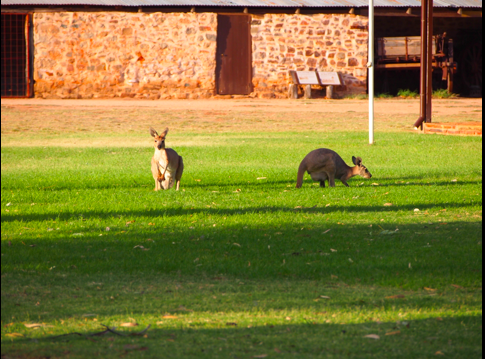
Kangaroos grazing at sunset at the telegraph station
The area resembles a remote outpost in America’s Old West, somewhere in Utah or Wyoming where the terrain is the endless dust, scrub brush, heat, and barrenness. We felt somewhat at home, since we grew up in the mid-West, a couple states north of Utah and Wyoming.
It is remote locations like Utah, Wyoming, and the Outback that adventurous pioneers cross to link to civilization and eventual settlement.
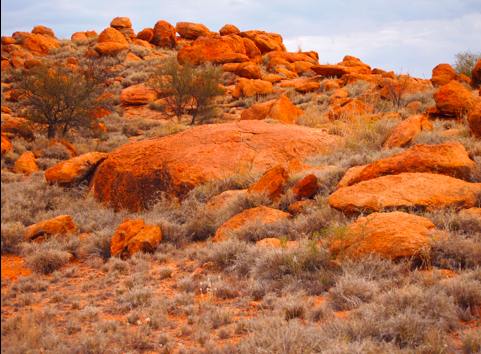
Kangaroo country around telegraph station
Grazing kangaroos
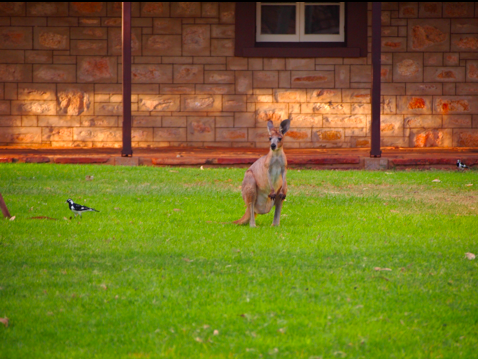
Grazing in telegraph station grounds
Dry Todd River bed
We walked from the grounds onto the dry, sandy bed of the Todd River which winds from the MacDonnell Range through Alice Springs and eventually the Simpson desert. Kangaroos were hopping across the river bed, digging for water, and climbing in boulders on the other side. We approached a few who kept an eye on us, letting us get only so close, then they would hop away into the boulders or the scrub brush.
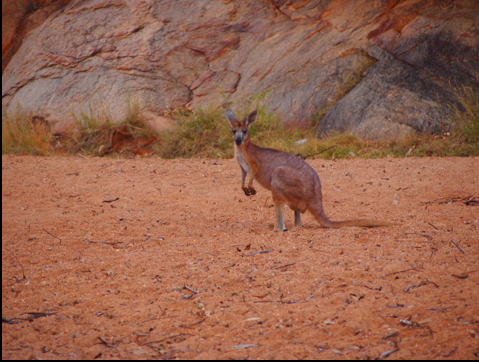
Wary kangaroo keeping an eye on us
One young kangaroo was busy digging a pit in the dry river bed for water. After he hopped away, we walked over to see that he had dug down about a meter, piling up the sand along the side.
Later that evening after we had moved down the river bed, he returned, watching us before he went down into the pit to resume digging.
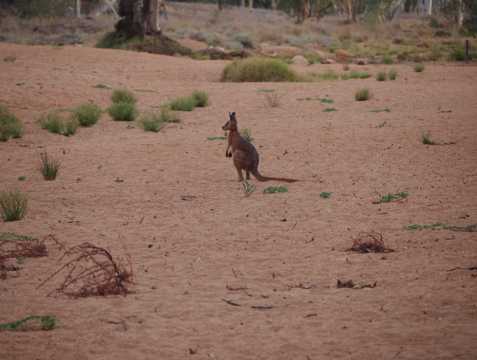
Hopping across the sandy river bed
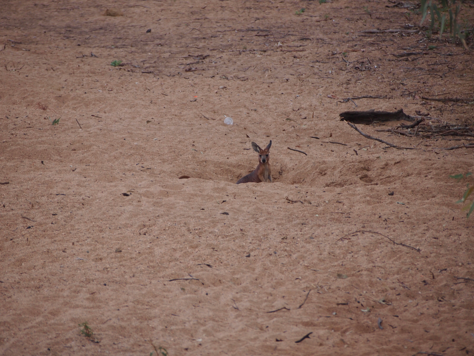
Digging for water in dry Todd River bed
Hiding in plain sight
Kangaroos blend into the environment so well you have to watch for movement. Their camouflage is their greyish red coats which are natural colors in the Outback. Kangaroos have no natural predators except hunters who try to track them down in the bush. That’s why there are many million of them. They survive in the bleakest, hottest areas, resting in the shade during the heat of the day, coming out at dusk to graze and move through the red desert.
In fading daylight at the telegraph station, it was sometimes hard to see them.
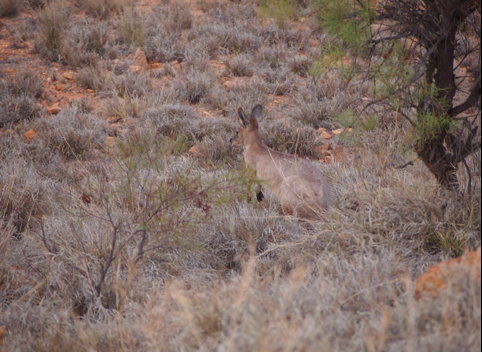
See her in the center?
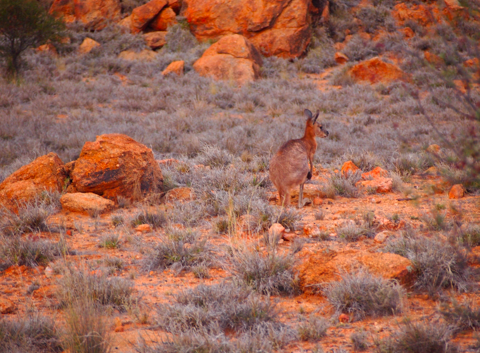
Blending into the landscape
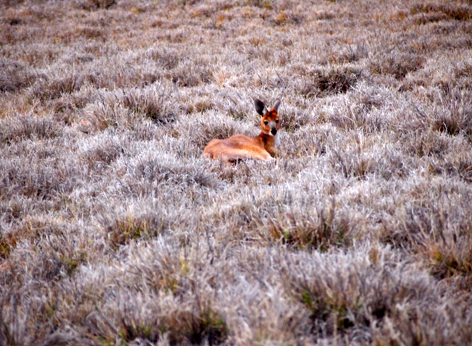
Hiding in plain sight
Bedding down in the bush
We saw three or four younger kangaroos resting in the bush. They watched us, then rose when we came closer and hopped away to the cover of a rocky bluff.
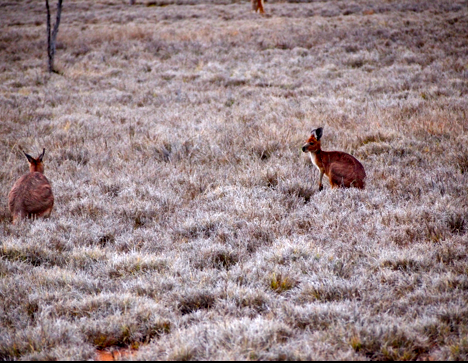
Pair of young reds, probably females
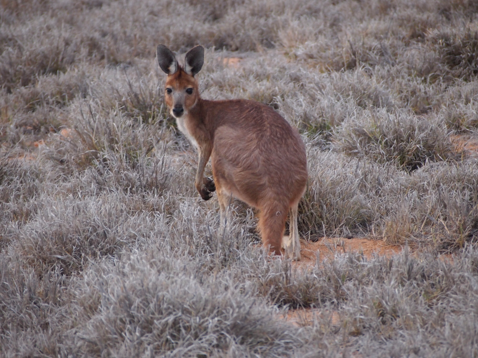
Watching us approach
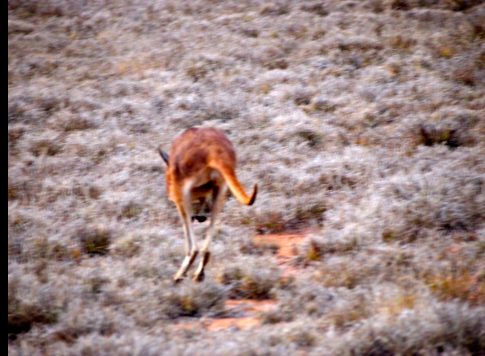
Hopping for cover
We saw the largest kangaroo walking back toward the station, an old male hiding in the brush. He watched us, then hopped into boulders on a hill and disappeared.
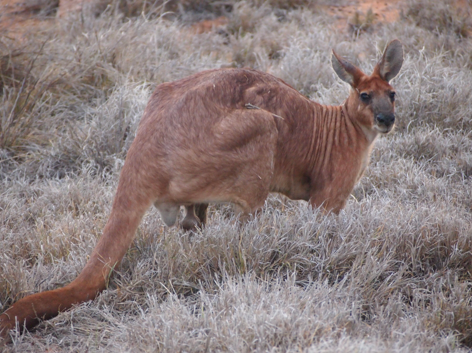
Old male red on guard
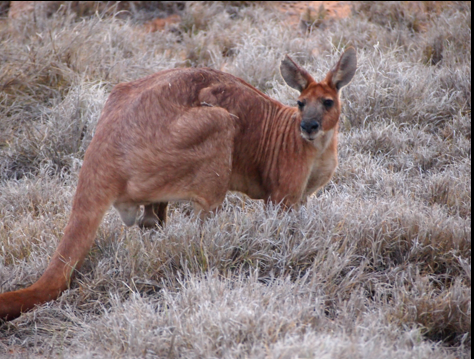
Seconds before he hopped between boulders and disappeared
It was thrilling to see so many kangaroos around the telegraph station. Almost everywhere we looked we saw them hopping, hiding in the bush, grazing, or digging in the river bed.
At dark, we left the telegraph station, driving slowly to avoid hitting one who might venture on the road. Many kangaroos are killed on the roads every evening, blinded by headlights.
Our evening at the telegraph station was our third encounter with kangaroos, the largest marsupials in the world. They’re magnificent creatures, beautiful, rugged, and unique in the animal kingdom.
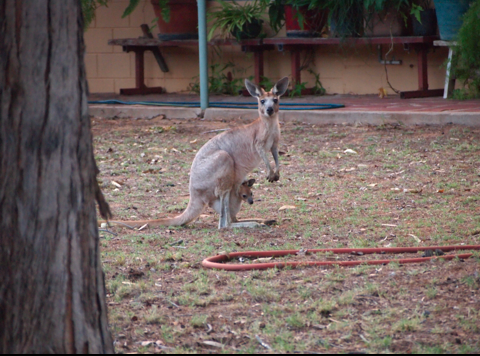
The last kangaroo we saw that evening, in the caretaker's yard
* * * * *
Next: Diving in the Great Barrier Reef
Please share your comments with us on travels Down Under. We want to hear from you!
In addition to this travel blog, I also write mysteries and romantic suspense novels available on Kindle, Nook,
and Smashwords which distributes to ereader devices. If you read books on ereaders, I hope you’ll consider
reading and reviewing them. I’ll be publishing a new murder mystery, REX ROYALE, in a few weeks. Let me
know if you’d like to read a preview of the opening chapters.
jacklerickson@gmail.com











